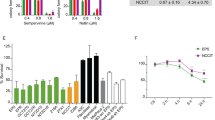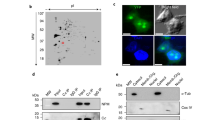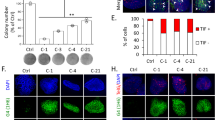Abstract
p53 is a key regulator of cell growth and death by controlling cell cycle progression and apoptosis under conditions of stress such as DNA damage or oncogenic stimulation. As these processes are critical for cell function and inhibition of tumor development, p53 regulatory pathways are strictly monitored in cells. Recently, it was recognized that nucleolar proteins, including nucleophosmin/B23, ribosomal protein L11, and alternate reading frame (ARF), form the nucleolus-ARF-murine double minute 2 (MDM2) axis in p53 regulatory pathways, which increases p53 stability by suppressing the activity of MDM2. In this work, we show that nucleolar protein glioma tumor-suppressor candidate region gene 2 (GLTSCR2) translocates to the nucleoplasm under ribosomal stress, where it interacts with and stabilizes p53 and inhibits cell cycle progression without the involvement of the major upstream p53 regulator, ARF. Furthermore, ectopic expression of GLTSCR2 significantly suppressed growth of cancer cells in a xenograft animal model via p53-dependent pathway. Our data identify GLTSCR2 as a new member of the nucleolus–nucleoplasmic axis for p53 regulation. ARF-independent direct regulation of p53 by GLTSCR2 may be a key mechanism and therapeutic target for cell death or growth inhibition when nucleolus-ARF-p53 pathways are inactivated by genetic or epigenetic modifications of ARF, which are the second most common types of genetic change observed in human cancers.
Similar content being viewed by others
Log in or create a free account to read this content
Gain free access to this article, as well as selected content from this journal and more on nature.com
or
Abbreviations
- ARF:
-
alternative reading frame
- GFP:
-
green fluorescence protein
- GLTSCR2 :
-
glioma tumor-suppressor candidate region gene 2
- GST:
-
glutathione S-transferase
- MDM2:
-
murine double minute 2
- NES:
-
nucleus export signal
- NLS:
-
nuclear localization signal
- NPM:
-
nucleophosmin
- NS:
-
nucleostemin
- RPL5:
-
ribosomal protein L5
References
Vogelstein B, Lane D, Levine AJ . Surfing the p53 network. Nature 2000; 16: 307–310.
Oren M . Decision making by p53: life, death and cancer. Cell Death Differ 2003; 10: 431–442.
Hollstein M, Sidransky D, Vogelstein B, Harris CC . p53 mutations in human cancers. Science 1991; 5: 49–53.
Haupt Y, Maya R, Kazaz A, Oren M . Mdm2 promotes the rapid degradation of p53. Nature 1997; 15: 296–299.
Kubbutat MH, Jones SN, Vousden KH . Regulation of p53 stability by Mdm2. Nature 1997; 15: 299–303.
Michael D, Oren M . The p53-Mdm2 module and the ubiquitin system. Semin Cancer Biol 2003; 13: 49–58.
Zhang Y, Lu H . Signaling to p53: ribosomal proteins find their way. Cancer Cell 2009; 6: 369–377.
Brady SN, Yu Y, Maggi LB, Weber JD . ARF impedes NPM/B23 shuttling in an Mdm2-sensitive tumor suppressor pathway. Mol Cell Biol 2004; 24: 9327–9338.
Lohrum MA, Ludwig RL, Kubbutat MH, Hanlon M, Vousden KH . Regulation of HDM2 activity by the ribosomal protein L11. Cancer Cell 2003; 3: 577–587.
Dai MS, Zeng SX, Jin Y, Sun XX, David L, Lu H . Ribosomal protein L23 activates p53 by inhibiting MDM2 function in response to ribosomal perturbation but not to translation inhibition. Mol Cell Biol 2004; 24: 7654–7668.
Dai MS, Lu H . Inhibition of MDM2-mediated p53 ubiquitination and degradation by ribosomal protein L5. J Biol Chem 2004; 279: 44475–44482.
Meng L, Lin T, Tsai RY . Nucleoplasmic mobilization of nucleostemin stabilizes MDM2 and promotes G2-M progression and cell survival. J Cell Sci 2008; 15: 4037–4046.
Sherr CJ . The INK4a/ARF network in tumour suppression. Nat Rev Mol Cell Biol 2001; 2: 731–737.
Pomerantz J, Schreiber-Agus N, Liégeois NJ, Silverman A, Alland L, Chin L et al. The INK4a tumor suppressor gene product, p19ARF, interacts with mdm2 and neutralizes mdm2’s inhibition of p53. Cell 1998; 92: 713–723.
Zhang Y, Xiong Y, Yarbrough WG . ARF promotes MDM2 degradation and stabilizes p53: ARF-INK4a locus deletion impairs both the Rb and p53 tumor suppression pathways. Cell 1998; 92: 725–734.
Saporita AJ, Maggi LB, Apicelli AJ, Weber JD . Therapeutic targets in the ARF tumor suppressor pathway. Curr Med Chem 2007; 14: 1815–1827.
Okahara F, Itoh K, Nakagawara A, Murakami M, Kanaho Y, Maehama T . Critical role of PICT-1, a tumor suppressor candidate, in phosphatidylinositol 3,4,5-trisphosphate signals and tumorigenic transformation. Mol Biol Cell 2006; 17: 4888–4895.
Kim Y-J, Cho Y-E, Kim Y-W, Kim J-Y, Lee S, Park J-H . Suppression of putative tumour suppressor gene GLTSCR2 expression in human glioblastomas. J Pathol 2008; 216: 218–224.
Okahara F, Ikawa H, Kanaho Y, Maehama T . Regulation of PTEN phosphorylation and stability by a tumor suppressor candidate protein. J Biol Chem 2004; 29: 45300–45303.
Yim J-H, Kim Y-J, Ko J-H, Cho Y-E, Kim S-M, Kim J-Y et al. The putative tumor suppressor gene GLTSCR2 induces PTEN-modulated cell death. Cell Death Differ 2007; 14: 1872–1879.
Colombo E, Marine JC, Danovi D, Falini B, Pelicci PG . Nucleophosmin regulates the stability and transcriptional activity of p53. Nat Cell Biol 2002; 4: 529–533.
Dai MS, Sun XX, Lu H . Aberrant expression of nucleostemin activates p53 and induces cell cycle arrest via inhibition of MDM2. Mol Cell Biol 2008; 28: 4365–4376.
Sakaguchi K, Sakamoto H, Lewis MS, Anderson CW, Erickson JW, Appella E et al. Phosphorylation of serine 392 stabilizes the tetramer formation of tumor suppressor protein p53. Biochemistry 1997; 19: 10117–10124.
Foo RS, Nam YJ, Ostreicher MJ, Metzl MD, Whelan RS, Peng CR et al. Regulation of p53 tetramerization and nuclear export by ARC. Proc Natl. Acad Sci USA 2007; 26: 20826–20831.
McLure KG, Lee PW . How p53 binds DNA as a tetramer. EMBO J 1998; 17: 3342–3350.
Shieh SY, Taya Y, Prives C . DNA damage-inducible phosphorylation of p53 at N-terminal sites including a novel site, Ser20, requires tetramerization. EMBO J 1999; 18: 1815–1823.
Maki CG . Oligomerization is required for p53 to be efficiently ubiquitinated by MDM2. J Biol Chem 1999; 274: 16531–16535.
Montanaro L, Treré D, Derenzini M . Nucleolus, ribosomes, and cancer. Am J Pathol 2008; 173: 301–310.
Emmott E, Hiscox JA . Nucleolar targeting: the hub of the matter. EMBO Rep 2009; 10: 231–238.
Kurki S, Peltonen K, Latonen L, Kiviharju TM, Ojala PM, Meek D et al. Nucleolar protein NPM interacts with HDM2 and protects tumor suppressor protein p53 from HDM2-mediated degradation. Cancer Cell 2004; 5: 465–475.
Bertwistle D, Sugimoto M, Sherr CJ . Physical and functional interactions of the Arf tumor suppressor protein with nucleophosmin/B23. Mol Cell Biol 2004; 24: 985–996.
Lambert B, Buckle M . Characterisation of the interface between nucleophosmin (NPM) and p53: potential role in p53 stabilisation. FEBS Lett 2006; 9: 345–350.
Kamijo T, Weber JD, Zambetti G, Zindy F, Roussel MF, Sherr CJ . Functional and physical interactions of the ARF tumor suppressor with p53 and Mdm2. Proc Natl Acad Sci USA 1998; 95: 8292–8297.
Weber JH, Taylor LJ, Roussel MF, Sherr CJ, Bar-Sagi D . Nucleolar ARF sequesters Mdm2 and activates p53. Nat Cell Biol 1999; 1: 20–26.
Serrano M . The INK4a/ARF locus in murine tumorigenesis. Carcinogenesis 2000; 21: 865–869.
Stommel JM, Marchenko ND, Jimenez GS, Moll UM, Hope TJ, Wahl GM . A leucine-rich nuclear export signal in the p53 tetramerization domain: regulation of subcellular localization and p53 activity by NES masking. EMBO J 1999; 18: 1660–1672.
Marston NJ, Jenkins JR, Vousden KH . Oligomerisation of full length p53 contributes to the interaction with mdm2 but not HPV E6. Oncogene 1995; 10: 1709–1715.
Chen J, Marechal V, Levine AJ . Mapping of the p53 and mdm-2 interaction domains. Mol Cell Biol 1993; 13: 4107–4114.
Kim JY, Seok KO, Kim YJ, Bae WK, Lee S, Park JH . Involvement of GLTSCR2 in the DNA damage response. Am J Pathol 2011; 179: 1257–1264.
Ma H, Pederson T . Nucleophosmin is a binding partner of nucleostemin in human osteosarcoma cells. Mol Biol Cell 2008; 19: 2870–2875.
Sasaki M, Kawahara K, Nishio M et al. Regulation of the MDM2-P53 pathway and tumor growth by PICT1 via nucleolar RPL11. Nat Med 2011; 17: 944–951.
Ma H, Pederson T . Depletion of the nucleolar protein nucleostemin causes G1 cell cycle arrest via the p53 pathway. Mol Biol Cell 2007; 18: 2630–2635.
Dai MS, Sun XX, Lu H . Aberrant expression of nucleostemin activates p53 and induces cell cycle arrest via inhibition of MDM2. Mol Cell Biol 2008; 28: 4365–4376.
Kim JY, Kim HS, Lee S, Park JH . The expression of GLTSCR2, a candidate tumor suppressor, is reduced in seborrheic keratosis compared to normal skin. Pathol Res Pract 2010; 206: 295–299.
Acknowledgements
This work was supported by the National Research Foundation of Korea (KRF) grant funded by the Korea government (MEST; no. 2011-0030725 and 2010-0010156 to SL). This work was performed during the sabbatical year (2011) of S Lee.
Author information
Authors and Affiliations
Corresponding author
Ethics declarations
Competing interests
The authors declare no conflict of interest.
Additional information
Edited by M Oren
Supplementary Information accompanies the paper on Cell Death and Differentiation website
Rights and permissions
About this article
Cite this article
Lee, S., Kim, JY., Kim, YJ. et al. Nucleolar protein GLTSCR2 stabilizes p53 in response to ribosomal stresses. Cell Death Differ 19, 1613–1622 (2012). https://doi.org/10.1038/cdd.2012.40
Received:
Revised:
Accepted:
Published:
Issue date:
DOI: https://doi.org/10.1038/cdd.2012.40
Keywords
This article is cited by
-
Changes in calpain-2 expression during glioblastoma progression predisposes tumor cells to temozolomide resistance by minimizing DNA damage and p53-dependent apoptosis
Cancer Cell International (2023)
-
Nucleolar protein NOC4L inhibits tumorigenesis and progression by attenuating SIRT1-mediated p53 deacetylation
Oncogene (2022)
-
Gene expression signatures of individual ductal carcinoma in situ lesions identify processes and biomarkers associated with progression towards invasive ductal carcinoma
Nature Communications (2022)
-
NOP53 undergoes liquid-liquid phase separation and promotes tumor radio-resistance
Cell Death Discovery (2022)
-
Downregulation of NOP53 Ribosome Biogenesis Factor Leads to Abnormal Nuclear Division and Chromosomal Instability in Human Cervical Cancer Cells
Pathology & Oncology Research (2020)



